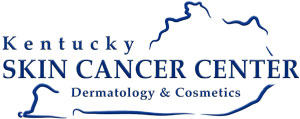Cancer is a scary word. No matter what kind you have or where it’s located, the news is unsettling, and all you want to do is get rid of it. But traditional cancer treatments can be traumatic, too.
Fortunately, there’s good news in the fight against skin cancer. Dr. Robert Skaggs at the Kentucky Skin Cancer Center leads the field in Mohs surgery, a game-changer in the treatment of basal cell and squamous cell carcinomas.
The Mohs surgery backstory
Today, Mohs surgery is considered the gold standard of skin cancer treatments, but it wasn’t long ago when doctors had no option but to cut deeply into healthy skin to access the cancerous portions or radiate it.
But in the 1930s, Frederic Mohs was a research assistant working on cancerous tissues in rats. Only 23 years old at the time, he stumbled upon a solution that allowed him to remove cancerous tissue and freeze it for lab work, while leaving other tissue intact. Once he became a surgeon, he developed and refined the procedure and successfully performed it on humans. Today, after continual refinement, the procedure still bears his name and remains the safest, most effective skin cancer treatment.
How is Mohs surgery different from traditional treatments?
In a nutshell, Mohs surgery is the process of removing very small, single layers of tissue one at a time to ensure only cancerous cells are removed and that healthy tissue stays healthy. Here’s the more detailed version:
1. Surgery prep
Unlike traditional open surgery, you only need a local anesthetic to numb the area during Mohs surgery. In most cases, you can wear your street clothes, depending on the location of the cancer. Dr. Skaggs answers all your questions and talks you through each step along the way.
2. The first layer
Dr. Skaggs lifts off a very thin layer of cancerous tissue and places it on a slide to view in our onsite lab. The goal is to take one layer at a time and never more than is necessary. This is one of the major differences between Mohs surgery and tradition excision: It’s incredibly precise.
3. Lab work
The technique discovered by Frederic Mohs decades ago still applies today. We freeze the tissue specimen and cut it onto sections that allow us to map out the path of your cancer and determine whether it mainly resides near the surface or it’s just the tip of the iceberg.
Once Dr. Skaggs examines the first layer, he knows whether it’s necessary to remove the next layer as well.
4. Wait
The only downside to Mohs surgery is that each time a layer of tissue is removed, you have to wait up to an hour for the results, but it’s a small price to pay for the precision and accuracy of the procedure. Besides, during the wait time, you can relax and read, listen to music, answer emails, or chat with a loved one.
5. All clear
Dr. Skaggs repeats the process several times until he sees that all the cancerous cells have been removed completely. It typically only takes one or two rounds, but be prepared for more, just in case. Most Mohs surgery patients spend about a half a day with us.
What to expect from Mohs surgery
Dr. Skaggs can perform Mohs surgery wherever your cancer shows up, but the most common places are where the sun hits most frequently: scalp, hands, face, ears, and feet. Rather than undergoing a painful excision that takes a chunk of your flesh and has low success rates (as low as 50%), Mohs surgery offers:
- Single-visit, outpatient procedure
- Onsite lab work
- Local, rather than general, anesthesia
- Preservation of healthy tissue
- Minimal scarring
- Up to 99% success rate
Given the extensive benefits of Mohs surgery and the lack of a downside, you may be wondering why it isn’t available everywhere. We’re glad you asked.
Why don’t all dermatologists perform Mohs surgery?
Mohs surgery is a highly specialized procedure that requires extensive education, skill, and hands-on training. Your surgeon needs to not only perform the procedure, including careful removal of diseased tissue and wound reconstruction, but they also must be an expert pathologist capable of analyzing lab specimens. Dr. Skaggs is one of Kentucky’s few fellowship-trained Mohs surgeons, which is why so many patients travel from throughout the state seeking his expertise.
If you or a loved one has skin cancer and want to learn more about whether you’re a good candidate for Mohs surgery, contact us at either of our two Kentucky locations in Bowling Green or Franklin today, or book your consultation online.






